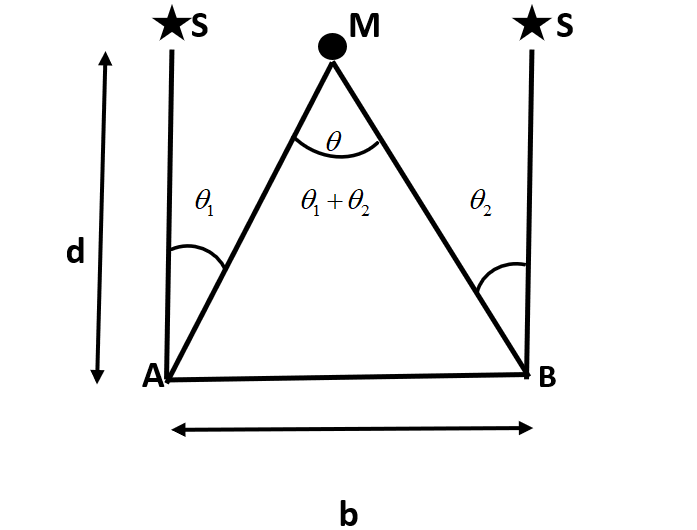
How is the distance between the Earth and the Moon calculated?
Answer
438.3k+ views
Hint: The distance between the Earth and the Moon can be measured using the Parallax method. A parallax is defined as the difference in the apparent position of an object, when viewed along two different lines of sight. It is measured by the angle or semi-angle of inclination between the two lines of sight. Therefore, while measuring shorter distances the angle of inclination is large and while measuring the distance of a far off distant object, the angle of inclination is very small.
Complete answer:
Let us first define some useful terms that are to be used:
D: the distance between the Earth and the moon.
b: the distance between the two points on Earth.
$\theta $ : the parallax angle.
Now, let us visualize the problem using the following diagram:

Here, we use a star S as reference. As it is too far away from the earth, we measure the angle that it makes, along the two different lines of sight.
Here,
AM and BM are the distance of the moon (M) from Earth, and
AB is the distance between the two points.
Thus, the whole set-up can be considered a part of a circle whose arc is AB with center M with the arc subtending an angle of ${{\theta }_{1}}+{{\theta }_{2}}$ at the center.
Therefore, for the arc we can write:
$\begin{align}
& \Rightarrow AM({{\theta }_{1}}+{{\theta }_{2}})=AB \\
& \Rightarrow D({{\theta }_{1}}+{{\theta }_{2}})=b \\
& \Rightarrow D=\dfrac{b}{{{\theta }_{1}}+{{\theta }_{2}}} \\
\end{align}$
Where,
$\Rightarrow {{\theta }_{1}}+{{\theta }_{2}}=\theta $ is the parallax angle.
Hence, the distance of the Moon from the Earth is calculated to be $\dfrac{b}{{{\theta }_{1}}+{{\theta }_{2}}}$ .
Note:
While using parallax method for distant objects, the point of references on Earth should be considerably apart so that we get a measurable a parallax angle as small angles are harder to measure. The distance of the moon from the Earth can be calculated using the principle of Lunar Eclipse also which uses the concept of similar triangles.
Complete answer:
Let us first define some useful terms that are to be used:
D: the distance between the Earth and the moon.
b: the distance between the two points on Earth.
$\theta $ : the parallax angle.
Now, let us visualize the problem using the following diagram:

Here, we use a star S as reference. As it is too far away from the earth, we measure the angle that it makes, along the two different lines of sight.
Here,
AM and BM are the distance of the moon (M) from Earth, and
AB is the distance between the two points.
Thus, the whole set-up can be considered a part of a circle whose arc is AB with center M with the arc subtending an angle of ${{\theta }_{1}}+{{\theta }_{2}}$ at the center.
Therefore, for the arc we can write:
$\begin{align}
& \Rightarrow AM({{\theta }_{1}}+{{\theta }_{2}})=AB \\
& \Rightarrow D({{\theta }_{1}}+{{\theta }_{2}})=b \\
& \Rightarrow D=\dfrac{b}{{{\theta }_{1}}+{{\theta }_{2}}} \\
\end{align}$
Where,
$\Rightarrow {{\theta }_{1}}+{{\theta }_{2}}=\theta $ is the parallax angle.
Hence, the distance of the Moon from the Earth is calculated to be $\dfrac{b}{{{\theta }_{1}}+{{\theta }_{2}}}$ .
Note:
While using parallax method for distant objects, the point of references on Earth should be considerably apart so that we get a measurable a parallax angle as small angles are harder to measure. The distance of the moon from the Earth can be calculated using the principle of Lunar Eclipse also which uses the concept of similar triangles.
Recently Updated Pages
The correct geometry and hybridization for XeF4 are class 11 chemistry CBSE

Water softening by Clarks process uses ACalcium bicarbonate class 11 chemistry CBSE

With reference to graphite and diamond which of the class 11 chemistry CBSE

A certain household has consumed 250 units of energy class 11 physics CBSE

The lightest metal known is A beryllium B lithium C class 11 chemistry CBSE

What is the formula mass of the iodine molecule class 11 chemistry CBSE

Trending doubts
Is Cellular respiration an Oxidation or Reduction class 11 chemistry CBSE

In electron dot structure the valence shell electrons class 11 chemistry CBSE

What is the Pitti Island famous for ABird Sanctuary class 11 social science CBSE

State the laws of reflection of light

One Metric ton is equal to kg A 10000 B 1000 C 100 class 11 physics CBSE

Difference Between Prokaryotic Cells and Eukaryotic Cells




